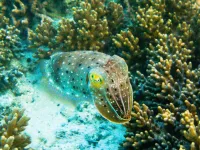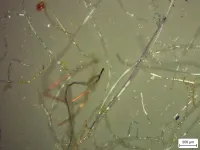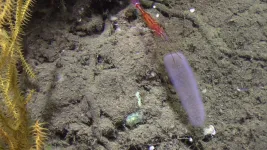(Press-News.org) University of Bristol research into octopus vision has led to a quick and easy test that helps optometrists identify people who are at greater risk of macular degeneration, the leading cause of incurable sight loss.
The basis for this breakthrough was published in the latest issue of the Journal of Experimental Biology and describes new technology developed by lead researcher, Professor Shelby Temple, to measure how well octopus- which are colour-blind - could detect polarized light, an aspect of light that humans can't readily see. Using this novel technology, the research team showed that octopus have the most sensitive polarization vision system of any animal tested to date. Subsequent research used the same technology in humans and led to the development of a novel medical device that assesses the risk factor for sight loss later in life.
Prof Shelby Temple, who holds honorary positions at the School of Biological Sciences, University of Bristol and the School of Optometry, Aston University, explained the impact of the team's findings. He said: "We knew that octopus, like many marine species, could see patterns in polarized light much like we see colour, but we had no idea that they could do so when the light was only 2% polarized - that was an exciting surprise, but even more surprising was when we then tested humans and found that they were able to see polarization patterns when the light was only 24% polarized.
"Humans can perceive polarized because macular pigments in our eyes differentially absorb violet-blue light depending on its angle of polarization, an effect known as Haidinger's brushes. It's like a super sense most of us don't even know we have, revealing a faint yellow bow-tie shape on the retina. The more of these pigments a person has, the better protected they are against sight-loss.
"By inventing a method to measure polarization vision in octopuses, we were able to use the core technology to develop a novel ophthalmic device that can quickly and easily screen people for low macular pigments, a strong risk factor for increased susceptibility to macular degeneration."
Macular pigments are the body's natural protection against damaging violet-blue light. This new testing approach enables optometrists to provide preventative advice to patients. Empowering patients to make simple lifestyle choices, like wearing sunglasses or eating more dark green and brightly coloured fruits and vegetables that can help them protect their sight through life.
Prof Temple said, "I am so happy this work has been published, as it was the foundation upon which we developed our exciting new technology for measuring macular pigments."
Macular pigments are the carotenoids lutein, zeaxanthin and meso-zeaxanthin that we can only acquire from our diet. They provide long term protection to the retina and this helps prevent age-related macular degeneration by acting as antioxidants and by strongly absorbing the most damaging high energy visible (violet-blue) wavelengths (380-500 nm) of light that reach our retina. A challenge to the eye care industry is that it is not possible to determine someone's macular pigment levels without measurement, and until now most techniques have been too time consuming, difficult, or expensive to become part of regular eye exams. The new technology developed by Prof Temple through his start-up company Azul Optics Ltd, enables rapid screening of macular pigment levels and can be used on patients from 5 -95 years of age. Prof Temple added: "We are all living longer and expecting to do more in our older age, so I hope this serendipitous invention will help empower people to do more to look after our eyes, so they don't suffer from this devastating disease."
INFORMATION:
Paper:
'Thresholds of polarization vision in octopuses' by Shelby Temple, Martin How, Nicholas Roberts et al, published in Journal of Experimental Biology
Notes for Editor
Age-related macular degeneration (AMD): is the leading cause of incurable blindness globally with over 288M predicted to be affected by 2050. AMD is caused by the long-term accumulation of damage with strong risk factors being age, genetics and smoking, violet-blue light exposure and low macular pigments.
What is polarized light? Light travels as a wave. The length of the waves we perceive as colour, and the orientation of the plane of vibration of the waves is their polarization. If light waves are randomly oriented, the light is unpolarized (0%), but if all of the waves are vibrating in the same plane, then the light is 100% polarized. Manmade light sources and filters often produce nearly 100% polarized light (e.g. LCD computer screens and polarized lenses in sunglasses and camera filters) but natural light rarely exceeds 70% polarization.
How humans and cephalopods detect polarised light differently: Octopus and cuttlefish use their photoreceptors, which are adapted to detect the orientation of polarized light, and are oriented vertically and horizontally across their retinas, whereas humans use the shadow formed on the retina by the absorption of violet-blue light by macular pigments that differentially absorb polarized light depending on orientation. This shadow forms faint yellow bowtie/hourglass like shape first described by Karl von Haidinger in 1844 and now bears his name (Haidinger's brushes).
Azul Optics Ltd: Is a start-up company based in Bristol UK, that took Prof Temple's fundamental research idea and translated it into a Class 1, CE marked medical device called the MP-eye. This simple to use tool empowers people to protect their eyes by giving eye care professionals a measurement of a patient's natural protective pigment levels that reinforces advice around how to protect against sight loss (e.g. wearing sunglasses, photochromic and blue filtering lenses, quitting smoking, increased consumption of lutein and zeaxanthin rich foods or supplements and weight management). For more information visit http://www.azuloptics.com
When COVID-19 patients began filling up ICUs throughout the country in 2020, health care providers faced difficult decisions. Health care workers had to decide which patients were most likely to recover with care and which were not so resources could be prioritized.
But a new paper from the University of Georgia suggests that unconscious biases in the health care system may have influenced how individuals with intellectual disabilities were categorized in emergency triage protocols.
The state-level protocols, while crucial for prioritizing care during disasters, frequently ...
(Boston)--If you come from a family where people routinely live well into old age, you will likely have better cognitive function (the ability to clearly think, learn and remember) than peers from families where people die younger. Researchers affiliated with the Long Life Family Study (LLFS) recently broadened that finding in a paper published in END ...
Brain implants are used to treat neurological dysfunction, and their use for enhancing cognitive abilities is a promising field of research. Implants can be used to monitor brain activity or stimulate parts of the brain using electrical pulses. In epilepsy, for example, brain implants can determine where in the brain seizures are happening.
Over time, implants trigger a foreign body response, creating inflammation and scar tissue around the implant that reduces their effectiveness.
The problem is that traditional implants are much more rigid than brain tissue, which has a softness comparable to pudding. Stress between the implant and ...
A new auroral phenomenon discovered by Finnish researchers a year ago is probably caused by areas of increased oxygen atom density occurring in an atmospheric wave channel. The speculative explanation offered by the researchers gained support from a new study.
Observations made by University of Helsinki researchers increased the validity of a speculative mechanism according to which a type of aurora borealis named 'dunes' is born. In the new study, photographs of the phenomenon taken by an international group of hobbyists in Finland, Norway and Scotland were compared to concurrent satellite data.
The rare type of aurora borealis was seen in the sky on 20 January 2016 and recorded in photos taken by ...
This overlay shows radio (orange) and infrared images of a giant molecular cloud called W49A, where new stars are being formed. A team of astronomers led by Chris DePree of Agnes Scott College used the National Science Foundation's Karl G. Jansky Very Large Array (VLA) to make new, high-resolution radio images of this cluster of still-forming, massive stars. W49A, 36,000 light-years from Earth, has been studied for many decades, and the new radio images revealed some tantalizing changes that have occurred since an earlier set of VLA observations in 1994 and 1995.
The ...
Scientists have developed a new "key-hole surgery" technique to extract metals from the earth - which could revolutionise the future of metal mining
A team of international researchers, including Dr Rich Crane from the Camborne School of Mines, University of Exeter, have developed a new method to extract metals, such as copper, from their parent ore body.
The research team have provided a proof of concept for the application of an electric field to control the movement of an acid within a low permeability copper-bearing ore deposit to selectively dissolve and recover the metal in situ.
This is in contrast to the conventional approach for the mining of such deposits ...
Swansea University scientists have uncovered potentially dangerous chemical pollutants that are released from disposable face masks when submerged in water.
The research reveals high levels of pollutants, including lead, antimony, and copper, within the silicon-based and plastic fibres of common disposable face masks.
The work is supported by the Institute for Innovative Materials, Processing and Numerical Technologies (IMPACT) and the SPECIFIC Innovation & Knowledge Centre
Project lead Dr Sarper Sarp of Swansea University College of Engineering said:
"All of us need to keep wearing masks as they are essential in ending the pandemic. But we also urgently need more research and regulation on mask production, so we can reduce any risks to the environment and ...
Pyrosomes, named after the Greek words for 'fire bodies' due their bright bioluminescence, are pelagic tunicates that spend their entire lives swimming in the open ocean. They are made up of many smaller animals, known as zooids, that sit together in a tubular matrix, known as tunic (hence the name pelagic tunicates). Because they live in the open ocean, they generally go unnoticed. In spite of this, increasing research points to their importance in marine environments, as they can form dense blooms that impact food web dynamics and contribute to the movement and transformation of organic carbon.
The study conducted with GEOMAR research vessel POSEIDON in 2018 and 2019 in the vicinity of the Cabo Verde Islands, of which the results have now been published ...
Scientists at the Walter Reed Army Institute for Research demonstrated that biomarkers associated with traumatic brain injury were elevated among law enforcement and military personnel, particularly in active duty participants with longer duration of service. Most notably, these elevated biomarker levels were observed in individuals without a diagnosed brain injury or concussion.
Some law enforcement and military personnel are regularly exposed to low levels of blast, particularly during training, due to the use of explosive charges and high caliber weapons. Understanding effects from these occupational exposures is a military health care priority to improve ...
FAYETTEVILLE, Ark. - A new map including rover paths of the Schrodinger basin, a geologically important area of the moon, could guide future exploration missions.The map was created by a team of interns at the Lunar and Planetary Institute, including Ellen Czaplinski, a University of Arkansas graduate student researcher at the Arkansas Center for Planetary Sciences and first author of a paper published in The Planetary Science Journal.
The researchers identified significant geologic features of the Schrödinger basin, located near the lunar south ...





